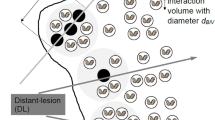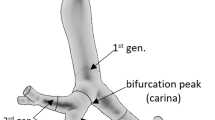Abstract
Large radiation doses to the lung can cause early death from cardiopulmonary insufficiency resulting from radiation pneumonitis and pulmonary fibrosis. A model for early death following inhalation of insoluble radioactive particles is propose. The model is based on three assumptions: (1) early death results from damage to a cluster of cells from a large number of cell clusters at risk, (2) the dose that causes early death depends on how the radiation is delivered in time and (3) the cell clusters at risk to damage are equally sensitive ro radiation. Results from asymptotic theory of extreme values, along with biophysical considerations, suggest that the cumultive distribution function for the absorbed radiation dose to the production of pulmonary injury sufficient to cause early death is best estimated by the third asymptotic distribution without a threshold. This distribution function is identical to the Weibull cumulative distribution function. Data for Beagle dogs after inhaling relatively insoluble forms of alpha- or beta-gamma-emitting particles are shown to support the Weibull model.
Similar content being viewed by others
Literature
Bresler S. E., V. L. Kalinin, Yu. I. Kopylova, A. S. Krivisky, V. N. Rybchin and V. N. Shelegedin. 1975. “Study of Genetic Effects of High Energy Radiations With Different Ionizing Capacities on Extracellular Phages.”Mutat. Res.,29, 1–20.
Chiang, C. L. 1961. “A Stochastic Study of the Life Table and its Applications. III. The Follow-Up Study With the Consideration of Competing Risks.”Biometrics,17, 57–78.
Clarke, W. J., and W. J. Bair. 1964. “Plutonium Inhalation Studies VI. Pathologic Effects of Inhaled Plutonium Particles in Beagle Dogs.”Hlth Phys.,10, 391–398.
Cutler, J. C. and F. Ederer, 1958. “Maximum Utilization of the Life Table Method in Analyzing Survival.”J. Chron. Dis.,8, 699–712.
Delattre, P. 1974. “Systems Approach of Theoretical Models in Radiobiology and Radiotherapy.”Int. J. Gen. Syst. 1, 105–117.
Diel, J. H. 1978. “Local Dose to the Deep Lung of Syrian Hamster From a Single238PuO2 Particle.”Radiat. Res. (in press).
Elkind, M. M. 1975. “A Summary and Review of the Conference.” InCell Survival After Low Doses of Radiation, Proceedings of the Sixth L. H. Gray Conference, Belford College, London, 16–21 September 1974, Ed. T. Alper: The Institute of Physics, pp. 373–388. New York: Wiley.
Fisher, R. A. and L. H. C. Tippett. 1928. “Limiting Forms of the Frequency Distribution of the Largest or Smallest Member of a Sample.”Proc. Camb. Phil. Soc. 24, 180–190, Cited from Pike M. C. 1966. “A Method of Analysis of a Certain Class of Experiments in Carcinogenesis.”Biometrics 22, 142–161. (1966).
Fréchet, M. 1927. “Sur la loi probabilité de l'écart maximum.”Ann Soc. pol. Math. (Cracow),6, 93–116. Cited from Pike, M. C. 1966. “A Method of Analysis of a Certain Class of Experiments in Carcinogenesis.”Biometrics 22, 142–161. (1966).
Gumbel, E. J. 1958.Statistics of Extremes. London: Columbia University Press.
Hahn, F. F. 1975. “Estimates of Mortality due to Radiation Pneumonitis and Pulmonary Ribrosis After Exposure to Radionuclide Releases in Hypothetical Light Water Reactor Accidents.” Prepared for the Division of Biomedical and Environmental Research, U.S. Energy Research and Development Administration, LF-50.
Hahn, F. F., B.B. Boecker, C. H. Hobbs, R. K. Jones, J. C. Lay, J. L. Mauderly, R. O. McClellan and J. A. Pickrell. 1976. “Toxicity of Inhaled144Ce in Fused Aluminosilicate Particles in Beagle Dogs IX.” InInhalation Toxicology Research Institute Annual Report, 1975–1976, LF-56, pp. 180–185.
Iberall, A. S. 1967. “Quantitative Modeling of Physiological Factors in Radiation Lethality.”Ann. NY Acad. Sci. 147, Art 1, 1–81.
Kaplan, E. L. and P. Meier. 1958. “Nonparametric Estimation From Incomplete Observations.”J. Am. Statist. Ass. 53, 457–481.
Katz, R., B. Ackerson, M. Homayoonfar and S. C. Sharma. 1971. “Inactivation of Cells by Heavy Ion Bombardment.”Radiat. Res.,47, 402–425.
Kellerer, A. M. and H. H. Rossi. 1972. “The Theory of Dual Radiation Action.”Curr. Top. Radiat. Res. Q. 8, 85–158.
Kellerer, A. M. 1978. “Frequency of α-Particles From239PuO2 in Lung Cells.”Rad. Environm. Biophys. 15, 13–19.
Lay, J. C., C. H. Hobbs, F. F. Hahn, R. K. Jones, J. L Mauderly, R. O. McClellan and J. A. Pickrell. 1976. “Toxicity of90Y in Fused Aluminosilicate Particles in Beagle Dogs VII.” InInhalation Toxicology Research Institute Annual Report, 1975–76 LF-56, pp. 172–175.
Lay, J. C., R. G. Cuddihy, F. F. Hahn, C. H. Hobbs, R. K. Jones, G. M. Kanapilly J. L. Mauderly, R. O. McClellan and J. A. Pickrell. 1976. “Toxicity of Inhaled91Y in Fused Aluminosilicate Particles in Beagle Dogs VII.” InInhalation Toxicology Research Institute Annual Report, 1975–76 LF-56, pp. 176–179.
Margolis, L. W. and T. L. Phillips. 1969. “Whole-Lung Irradiation of Metastatic Tumor.”Radiology 93, 1173–1179.
Moosavi, H., S. McDonald, P. Rubin, R. Cooper, I. D. Stuard and D. Penney. 1977. “Early Radiation Dose-Response in Lung: An Ultrastructural Study.”Int. J. Radiat. Oncol. Biol. Phys. 2, 921–931.
Park, J. F., E. B. Howard and W. J. Bair. 1970. “Acute Toxicity of Inhaled238PuO2 in Beagles.” InPacific Northwest Laboratory Annual Report. BNWL-1050, part 1, pp.3.6–3.13.
Phillips, T. L. 1966. “An Ultrastructural Study of the Development of Radiation Injury in the Lungs.”Radiology 87, 49–54.
Pike, M. C. 1966. “A Method of Analysis of a Certain Class of Experiments in Carcinogenesis.”Biometrics 22, 142–161.
Roesch, W. C. 1976. “Microdosimetry of Internal, Particulate Sources.” InThe Health Effects of Plutonium and Radium. Ed. Webster S. S. Jee, pp. 669–680. Salt Lake City, Utah: The J.W. Press.
Sacher, G. A. 1956. “On the Statistical Nature of Mortality, With Special Reference to Chronic Radiation Mortality.”Radiology 67, 250–257.
Scott, B. R. 1977. “Mechanistic State Vector Model for Cell Killing by Ionizing Radiation.”Rad. Environm. Biophys. 14, 195–211.
Scott, B. R. 1978. “Hazard-Function Method of Resolving Radiation Dose-Response Curves.”Hlth Phys. (in press).
Smith, J. C. 1963. “Radiation Pneumonitis.”Am. Rev. Resp. Dis. 87, 647–655.
Snipes, M. B., B. B. Boecker, F. F. Hahn, C. H. Hobbs, J. L. Mauderly, R. O. McClellan and J. A. Pickrell. 1976. “Toxicity of Inhaled90Sr in Fused Aluminosilicate Particles in Beagle Dogs, VII. InInhalation Toxicology Research Institute Annual Report, 1975–76, LF-56, pp. 195–199.
Task Group on Lung Dynamics 1966. “Deposition and Retention Models for Internal Dosimetry of the Human Respiratory Tract.”Hlth Phys. 12, 173–207.
Todd, P. 1967. “Heavy-Ion Irradiation of Cultured Human Cells.”Radiat. Res. Suppl. 7, 196–207.
Upton, A. C. 1969.Radiation Injury. London: The University of Chicago Press.
Author information
Authors and Affiliations
Rights and permissions
About this article
Cite this article
Scott, B.R. A model for early death caused by radiation pneumonitis and pulmonary fibrosis after inhaling insoluble radioactive particles. Bltn Mathcal Biology 42, 447–459 (1980). https://doi.org/10.1007/BF02460795
Received:
Revised:
Issue Date:
DOI: https://doi.org/10.1007/BF02460795




